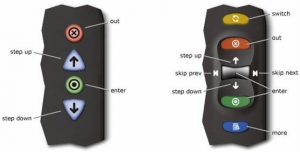Xeel: Difference between revisions
From BetaArchive Wiki
m (I am truly sorry for the mistake.) |
No edit summary |
||
| Line 1: | Line 1: | ||
[[File:MicrosoftXeel.png|right|thumb|"Xeel" remotes. A remote with navigational controls for simpler devices <small>(left)</small> and a remote for devices with | [[File:MicrosoftXeel.png|right|thumb|"Xeel" remotes. A remote with navigational controls for simpler devices <small>(left)</small> and a remote for devices with additional functionality <small>(right)</small>.]] | ||
'''"Xeel"''' was the codename for a set of hardware-based navigational controls designed by [[Microsoft]] to create a simplified and consistent user experience for devices running the [[Windows]] operating system.<ref>Hachman, Mark. (May 5, 2003). [http://www.extremetech.com/extreme/54090-update-gates-to-unify-windows-around-mouse-wheel "Update: Gates To Unify Windows Around Mouse Wheel"]</ref><ref>Microsoft. (May 6, 2003). [http://www.microsoft.com/en-us/news/press/2003/may03/05-06winhec2003keynotepr.aspx "Bill Gates Unveils Next Wave of Windows PC Innovation at WinHEC 2003"]</ref><ref>Olavsrud, Thor. (May 6, 2003). [http://www.datamation.com/entdev/article.php/2201781/Microsoft-HP-Show-Path-to-PC-Renaissance.htm "Microsoft, HP Show Path to PC Renaissance"]</ref><ref>Microsoft. (May 7, 2003). [http://www.microsoft.com/en-us/news/exec/poole/05-07winhec.aspx "Speech Transcript - Will Poole, Windows Hardware Engineering Conference (WinHEC) 2003"]</ref> | '''"Xeel"''' was the codename for a set of hardware-based navigational controls designed by [[Microsoft]] to create a simplified and consistent user experience for devices running the [[Windows]] operating system.<ref>Hachman, Mark. (May 5, 2003). [http://www.extremetech.com/extreme/54090-update-gates-to-unify-windows-around-mouse-wheel "Update: Gates To Unify Windows Around Mouse Wheel"]</ref><ref>Microsoft. (May 6, 2003). [http://www.microsoft.com/en-us/news/press/2003/may03/05-06winhec2003keynotepr.aspx "Bill Gates Unveils Next Wave of Windows PC Innovation at WinHEC 2003"]</ref><ref>Olavsrud, Thor. (May 6, 2003). [http://www.datamation.com/entdev/article.php/2201781/Microsoft-HP-Show-Path-to-PC-Renaissance.htm "Microsoft, HP Show Path to PC Renaissance"]</ref><ref name="Microsoft.">Microsoft. (May 7, 2003). [http://www.microsoft.com/en-us/news/exec/poole/05-07winhec.aspx "Speech Transcript - Will Poole, Windows Hardware Engineering Conference (WinHEC) 2003"]</ref> "Xeel" was first demonstrated during Microsoft's [[Windows Hardware Engineering Conference 2003|Windows Hardware Engineering Conference of 2003]], where it was characterized as a result of the synergy between hardware and software. Microsoft stated that its design goal for "Xeel" was to create a consistent experience for hardware devices that equaled the software interface consistency introduced by the mouse scroll wheel.<ref name="Microsoft.">Microsoft. (May 7, 2003). [http://www.microsoft.com/en-us/news/exec/poole/05-07winhec.aspx "Speech Transcript - Will Poole, Windows Hardware Engineering Conference (WinHEC) 2003"]</ref> | ||
==References== | ==References== | ||
<references/> | <references/> | ||
[[Category:Cancelled Projects]] | [[Category:Cancelled Projects]] | ||
Revision as of 07:27, 20 August 2014
"Xeel" was the codename for a set of hardware-based navigational controls designed by Microsoft to create a simplified and consistent user experience for devices running the Windows operating system.[1][2][3][4] "Xeel" was first demonstrated during Microsoft's Windows Hardware Engineering Conference of 2003, where it was characterized as a result of the synergy between hardware and software. Microsoft stated that its design goal for "Xeel" was to create a consistent experience for hardware devices that equaled the software interface consistency introduced by the mouse scroll wheel.[4]
References
- ↑ Hachman, Mark. (May 5, 2003). "Update: Gates To Unify Windows Around Mouse Wheel"
- ↑ Microsoft. (May 6, 2003). "Bill Gates Unveils Next Wave of Windows PC Innovation at WinHEC 2003"
- ↑ Olavsrud, Thor. (May 6, 2003). "Microsoft, HP Show Path to PC Renaissance"
- ↑ 4.0 4.1 Microsoft. (May 7, 2003). "Speech Transcript - Will Poole, Windows Hardware Engineering Conference (WinHEC) 2003"
